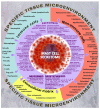Mast Cells as a Potential Target of Molecular Hydrogen in Regulating the Local Tissue Microenvironment
- PMID: 37375765
- PMCID: PMC10300919
- DOI: 10.3390/ph16060817
Mast Cells as a Potential Target of Molecular Hydrogen in Regulating the Local Tissue Microenvironment
Abstract
Knowledge of the biological effects of molecular hydrogen (H2), hydrogen gas, is constantly advancing, giving a reason for the optimism in several healthcare practitioners regarding the management of multiple diseases, including socially significant ones (malignant neoplasms, diabetes mellitus, viral hepatitis, mental and behavioral disorders). However, mechanisms underlying the biological effects of H2 are still being actively debated. In this review, we focus on mast cells as a potential target for H2 at the specific tissue microenvironment level. H2 regulates the processing of pro-inflammatory components of the mast cell secretome and their entry into the extracellular matrix; this can significantly affect the capacity of the integrated-buffer metabolism and the structure of the immune landscape of the local tissue microenvironment. The analysis performed highlights several potential mechanisms for developing the biological effects of H2 and offers great opportunities for translating the obtained findings into clinical practice.
Keywords: inflammation; local tissue microenvironment; mast cells; molecular hydrogen; reactive oxygen intermediates; secretome; specific mast cell proteases.
Conflict of interest statement
The authors declare no conflict of interest.
Figures


Similar articles
-
Mast cell chymase: morphofunctional characteristics.Histochem Cell Biol. 2019 Oct;152(4):253-269. doi: 10.1007/s00418-019-01803-6. Epub 2019 Aug 8. Histochem Cell Biol. 2019. PMID: 31392409 Review.
-
Mechanisms Underlying the Biological Effects of Molecular Hydrogen.Curr Pharm Des. 2021;27(5):626-735. doi: 10.2174/1381612826666201211112846. Curr Pharm Des. 2021. PMID: 33308112
-
Molecular hydrogen as a preventive and therapeutic medical gas: initiation, development and potential of hydrogen medicine.Pharmacol Ther. 2014 Oct;144(1):1-11. doi: 10.1016/j.pharmthera.2014.04.006. Epub 2014 Apr 24. Pharmacol Ther. 2014. PMID: 24769081 Review.
-
Hydrogen, a Novel Therapeutic Molecule, Regulates Oxidative Stress, Inflammation, and Apoptosis.Front Physiol. 2021 Dec 20;12:789507. doi: 10.3389/fphys.2021.789507. eCollection 2021. Front Physiol. 2021. PMID: 34987419 Free PMC article. Review.
-
Mast Cells in the Tumor Microenvironment.Adv Exp Med Biol. 2020;1273:159-173. doi: 10.1007/978-3-030-49270-0_9. Adv Exp Med Biol. 2020. PMID: 33119881 Review.
Cited by
-
Immunomodulatory Significance of Mast Cell Exosomes (MC-EXOs) in Immune Response Coordination.Clin Rev Allergy Immunol. 2025 Feb 20;68(1):20. doi: 10.1007/s12016-025-09033-6. Clin Rev Allergy Immunol. 2025. PMID: 39976807 Free PMC article. Review.
-
Cuproptosis, the novel type of oxidation-induced cell death in thoracic cancers: can it enhance the success of immunotherapy?Cell Commun Signal. 2024 Jul 27;22(1):379. doi: 10.1186/s12964-024-01743-2. Cell Commun Signal. 2024. PMID: 39068453 Free PMC article. Review.
-
The Role of Mast Cells in the Remodeling Effects of Molecular Hydrogen on the Lung Local Tissue Microenvironment under Simulated Pulmonary Hypertension.Int J Mol Sci. 2024 Oct 13;25(20):11010. doi: 10.3390/ijms252011010. Int J Mol Sci. 2024. PMID: 39456794 Free PMC article.
-
Cyto- and Histopographic Assessment of CPA3-Positive Testicular Mast Cells in Obstructive and Non-Obstructive Azoospermia.Cells. 2024 May 14;13(10):833. doi: 10.3390/cells13100833. Cells. 2024. PMID: 38786055 Free PMC article.
-
The Impact of Mast Cells on the Anatomy, Cellular Communication, and Molecular Immune Network of Lymph Nodes.Clin Rev Allergy Immunol. 2025 Apr 2;68(1):35. doi: 10.1007/s12016-025-09050-5. Clin Rev Allergy Immunol. 2025. PMID: 40175843 Free PMC article. Review.
References
-
- De Almeida A., de Oliveira J., da Silva Pontes L.V., de Souza Junior J.F., Goncalves T.A.F., Dantas S.H., de Almeida Feitosa M.S., Silva A.O., de Medeiros I.A. ROS: Basic Concepts, Sources, Cellular Signaling, and its Implications in Aging Pathways. Oxid. Med. Cell. Longev. 2022;2022:1225578. doi: 10.1155/2022/1225578. - DOI - PMC - PubMed
-
- Villarreal-Garcia V., Estupinan-Jimenez J.R., Vivas-Mejia P.E., Gonzalez-Villasana V., Vazquez-Guillen J.M., Resendez-Perez D. A vicious circle in breast cancer: The interplay between inflammation, reactive oxygen species, and microRNAs. Front. Oncol. 2022;12:980694. doi: 10.3389/fonc.2022.980694. - DOI - PMC - PubMed
Publication types
LinkOut - more resources
Full Text Sources

